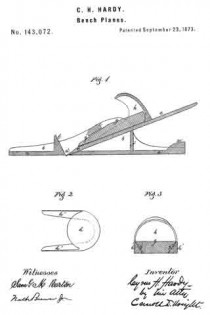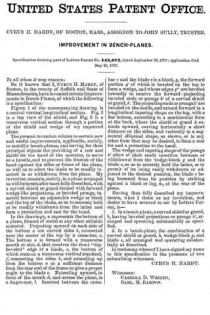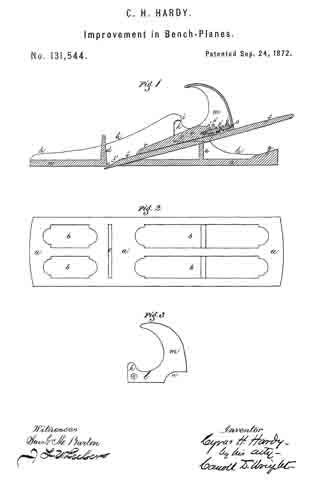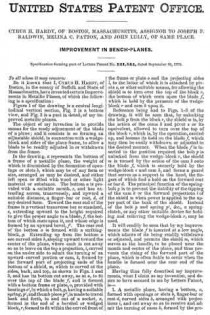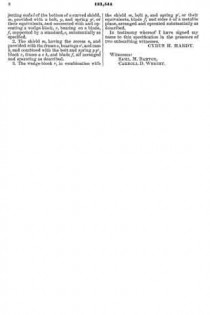No. 143,072 – Improvement In Bench-Planes (Cyrus H. Hardy) (1873)
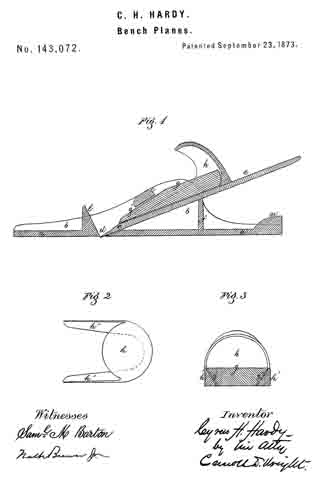
UNITED STATES PATENT OFFICE.
_________________
CYRUS H. HARDY, OF BOSTON, MASS., ASSIGNOR TO JOHN SULLY, TRUSTEE.
IMPROVEMENT IN BENCH-PLANES.
_________________
Specification forming part of Letters Patent No. 143,072, dated September 23, 1873; application filed May 28, 1873.
_________________
To all whom it may concern:
Be it known that I, CYRUS H. HARDY, of Boston, in the county of Suffolk and State of Massachusetts, have invented certain Improvements in Bench-Planes, of which the following is a specification:
Figure 1 of the accompanying drawing is a central vertical longitudinal section. Fig. 2 is a top view of the shield, and Fig. 3 is a transverse vertical section through a portion of the shield and wedge of my improved plane.
The present invention relates to certain new and useful improvements, applicable, mainly, to metallic bench-planes, and having for their principal objects the providing of a rest and shield for the hand of the operator, to serve as a handle, and to prevent the friction of the hand against the sides or frame of the plane, as well as to allow the blade to be readily inserted in or withdrawn from the plane. My invention consists, mainly, in a plane arranged as will be hereinafter more fully described, with a curved shield or guard formed with forward wedge-like projections, or beveled prongs, inserted between an adjustable wedge or block and the top of the blade, so as to securely hold or be readily withdrawn from the latter and form a protection and rest for the hand.
In the drawings, a represents the bottom of a plane, formed of metal or any other suitable material. Projecting upward on each side of the bottom a are curved sides b, connected near the center at the top by a cross-bar, c. The bottom a is formed with a transverse mouth or slot, d, that receives the front “top-beveled” edge of a blade, e, the bottom of which rests on a transverse vertical standard, f, connecting the sides b, and extending up from the bottom a at a sufficient distance from the rear end of the frame to give a proper angle to the blade e. Extending upward, in front of the mouth d, and across the plane, is a finger-rest, l. Inserted between the cross-bar c and the blade e is a block, g, the forward portion g’ of which is beveled on the top to form a wedge, and whose edges g” are beveled inwardly to receive the forward-projecting beveled ends or prongs Ih’ of a curved shield or guard, h. The projecting ends or prongs h’ are beveled on the inside, and extend forward in a longitudinal tapering shape on the top, with a flat bottom, extending in a semicircular form at the back, where the shield or guard It extends upward, curving horizontally a short distance on the sides, and vertically in a segmental elliptical shape, as shown, or in any other form that may be desired, to form a rest for and a protection to the hand.
The wedge and tapering shape of the prongs h’ allow of their ready insertion between or withdrawal from the wedge-block g and the blade e, so as to securely hold the latter, or to permit of its being easily withdrawn or adjusted to the desired position, the blade e being loosened from its position by striking against a block or lug, m, at the rear of the plane.
Having thus fully described my improvements, what I claim as my invention, and desire to have secured to me by Letters Patent, is —
1. In a bench-plane, a curved shield or guard, lt, having beveled projections or prongs h’, arranged and operating substantially as specified.
2. In a bench-plane, the combination of a curved shield or guard, h, wedge-block g, and blade e, all arranged and operating substantially as described.
In testimony whereof I have signed my name to this specification in the presence of two subscribing witnesses.
CYRUS H. HARDY.
Witnesses:
CARROLL D. WRIGHT,
SAML. M. BARTON.

